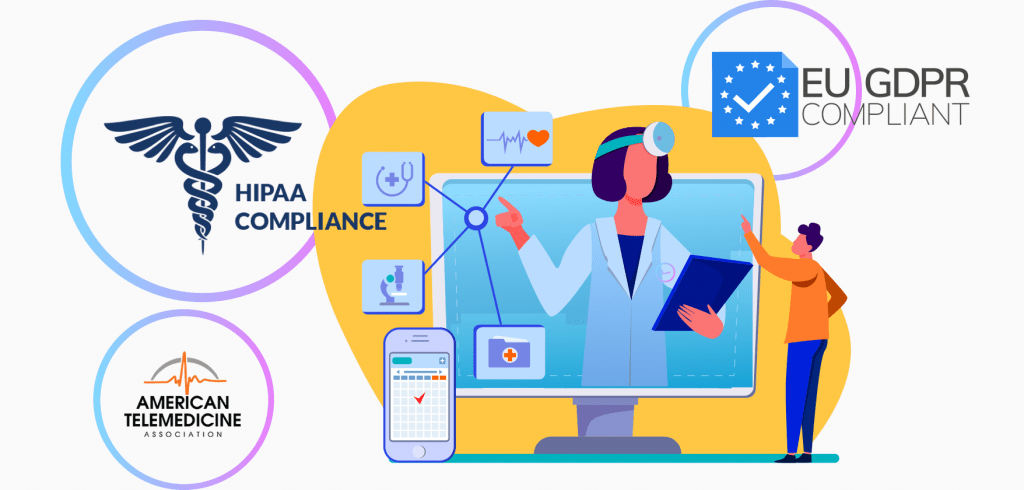Recently updated on April 15, 2024
With the fitness obsession; the rapid growth of the healthy foods market; the popularity of the self-care idea; and current coronavirus events that entangled the world with the slithery tentacles of anxiety, health consciousness is on the rise. Still, going to a hospital in case of health issues is not at the top of people’s “do it ASAP!” lists though. When you think about medical establishments, imagination pictures long queues, a unique and tense atmosphere, stressed-out people, and unpleasant connotations. Add to this long commute, the rarity of free time in the era of busyness, possibly high costs, and you will have people who go to a hospital as a last resort only. Remote healthcare solutions, aka telemedicine, can be a solution that drives more people to get required medical help/consultancy ASAP and increases the number of healthcare establishments’ patients.
In this article, you will learn more about telemedicine, a little about its history, the functionality of modern telemedicine apps, and the approach to developing such software.
Content:
1. What is Telemedicine? Brief History
2. The Functionality of a Telemedicine Platform
3. The Process of Creating a Telemedicine Platform
4. Regulatory Environment Considerations
5. The Price of Developing a Telemedicine Solution
6. Conclusion
What is Telemedicine? Brief History
A telemedicine platform is a software solution that is used to provide remote healthcare services. Telemedicine is generally regarded as a synonym for telehealth.
Modern telemedicine solutions implement the latest technology to make the service instantaneous. The concept of remote healthcare isn’t novel though. The need to receive medical help without leaving one’s home is as old as healthcare providers and patients who, due to the reasons of age, disability, or illness, weren’t able to get to doctors, shamans, priests, or whichever ancient persona of the healthcare vocation. Sharing information about medical-related events was a point of concern as well. For example, in Africa people were using smoke signals to inform others that villagers are infected with a serious disease, so wanderers better stay away from the settlement. (We assume it also worked as a great way of avoiding unwelcome guests).

Years passed by, technology evolved, and when humankind’s bright minds ‘stumbled upon’ the wonders of radio, we tried harnessing its power for remote healthcare as well. You may have heard the story that is half-seriously considered the first ‘telemedicine event.’ According to it, in 1876, Alexander Bell, a telephone inventor, used one of the first prototypes to summon his assistant for help when the man spilled acid on his trousers. However, this anecdote about the clumsy inventor with acid on his pants does not have any reliable proof and can be regarded as a nice urban legend. So, we need a more concrete example with a systemic approach to consider it a real telemedicine practice. For instance, in the early 1900s, “people living in remote areas in Australia used two-way radios, powered by a dynamo driven by a set of bicycle pedals, to communicate with the Royal Flying Doctor Service of Australia.” The idea remained, while the ways of achieving it evolved.
Now, some 100 years later, we have videoconferencing, instantaneous messaging, convenient scheduling tools, chatbots, AI, big data, and machine learning, to make the dreams of remote healthcare a pleasant reality.
As a result, humanity has an abundance of doctor-on-demand customer service applications as well as the words with the suffixes ‘tele:’ telesurgery, teleophthalmology, teledermatology, telepathology, teleradiology, telepsychiatry, telecardiology, telerehabilitation, teleaudiology, and much more. Regardless of the name though they share similar functionality and require similar approaches to development.
The Functionality of a Telemedicine Platform
Telemedicine practices came a long way. A modern telemedicine application for healthcare embodies a broad spectrum of tools and approaches to make remote medicine smooth and effective. A telemedicine application is a secure and reliable piece of tech with complex and diverse functionality. Note, that such applications come in different shapes and sizes: smartphone apps, complex cloud-based infrastructures with different clients, web-based apps, etc. Regardless of the package and flavour of a telehealth app, they all have some features in common. Keep in mind here that any telemedicine app is created to minimize the amount of time that patients should spend in medical establishments. So, a well-rounded telemedicine app has the following functionality:

Video Conferences and Chatting
At the core of any telemedicine system is the possibility for doctors to connect with the patients directly to diagnose and/or provide consultations. Depending on the complexity and niche of the platform it can be done by implementing video conferencing or chatting/calls with photo-sharing features. For instance, experienced dermatologists can provide accurate diagnosis using a simple photo. However, a telemedicine video platform is definitely the most demanded and convenient option.
Booking and Scheduling
The name speaks for itself: a telehealth platform should allow booking appointments and managing schedules for maximal efficiency.
Medical Records Hub
There should be medical records storage, which is constantly updated and contains all relevant information and patient medical history.
Prescription
In addition, doctors should be able to prescribe drugs using the app. Moreover, it’s great when the app has relevant information about medications so a user doesn’t have to go on a googling spree to find out all information about prescribed drugs. Besides, a googling spree may lead a patient to outdated or simply wrong information.
Billing
It’s convenient when a patient can pay for a virtual visit or other services he or she obtained directly via a telemedicine app.
Reports and Analysis
Data analysis and reporting are more of a peasant feature for healthcare establishments that want to monitor their performance, number of patients, revenue fluctuations, etc.
Overall, if you decide to hire a software development team and create a custom telemedicine software platform, you will have the privilege to choose the exact functions and features your system should have.
The Process of Creating a Telemedicine Platform
If you are to build software for doctors, you will face a typical software development lifecycle, which can be roughly divided into the following stages.
Idea and research (Business Analysis Stage)
During this stage, business analytics take your idea and transform it into an actionable plan, which can be used as the foundation for the future app. This is a crucial stage, during which the market and competitors will be analyzed to develop accurate blueprints of the system.
Design
After business analysis, UI/UX designers can use its results to craft an appealing interface of the system that both doctors and patients will enjoy interacting with.
At KindGeek, we have the Discovery Phase proposition that combines business analysis and design stages into one petite bundle of all fundamentals required for further development of a successful product. In addition, it provides cost estimates.
Software development
Now it’s time to actually create a telemedicine platform. This is a complex and intricate stage, which will involve a variety of software development professionals (front end, back end, mobile, full-stack devs). Fortunately, they will have a solid foundation and accurate plans from the previous stages. For experienced programmers, telemedicine app development is simply a matter of time.
Support and Maintenance
After your telemedicine solution is deployed it should be updated and supported so it stays reliable and productive regardless of the circumstances.
Consider that the explanation of the development process above is simplified to give you a general idea about how such complex software as a telemedicine platform is being developed.
Regulatory Environment Considerations

Also, if you are to make a telemedicine application for healthcare, you should consider the regulatory environment of the country in which it will operate. Each country has its legal requirements that telemedicine apps should comply with. For instance, the USA has HIPAA, and the American Telemedicine Association conducted thorough research and created guidelines with the required practices in clinical, administrative, and technical spheres. On the other hand, the regulatory environment of the European Union is not completely solid yet. Its recent “achievements in the domain” include 2011/24/EU, Directive 95/46/EU, Directive 2000/31/EC, and Directive 2002/58/EC, and also GDPR, never forget about GDPR. Though some new legislation may be on the way, so it’s better to keep an eye on it. Here you can find a thorough comparison of the UK regulations to the regulations in other countries so you can better understand different nuances and approaches. Overall, during the development of telemedicine software, legal frameworks and regulatory environment should be your major concern.
The Price of Developing a Telemedicine Solution
Unfortunately, we cannot hit you with the exact amount of money for creating a telehealth app. Any amount of money we could provide here simply wouldn’t be accurate considering the nuances and intricacies of software development.
Thus, depending on the complexity of a product to create, software developers rates, absence or presence of fundamentals (design mockups, wireframes, etc), and a requirement for business analysis expertise, the price for a telemedicine platform could start in 4 zeroes and venture into 5 to 6 zeroes territory. As follows, the best decision here is to conduct the discovery phase, or something similar to that, in order to estimate the costs of the development.
For example, the discovery phase on top of providing price estimates, depending on the chosen package will give you
– product concept from Product Manager
– prototypes from Business Analyst
– visual concept from UI/UX Designer
– architecture concept from System Architect
The discovery phase is especially useful if you want to determine telemedicine startup costs because it will also give you tangible results that can be used to attract new investors.
Conclusion
It’s time for a shameless plug. Developing a telemedicine platform requires some heavy lifting. We know it well because KindGeek has had its share of experience in the healthcare niche, creating digital solutions for management and telemedicine service.
Therefore, if you want to create a telemedicine platform to boost your patients’ engagement, decrease the rates of doctors stressing out, and simply enter the new era of healthcare, we can help you.
Contact us, if you are interested.



